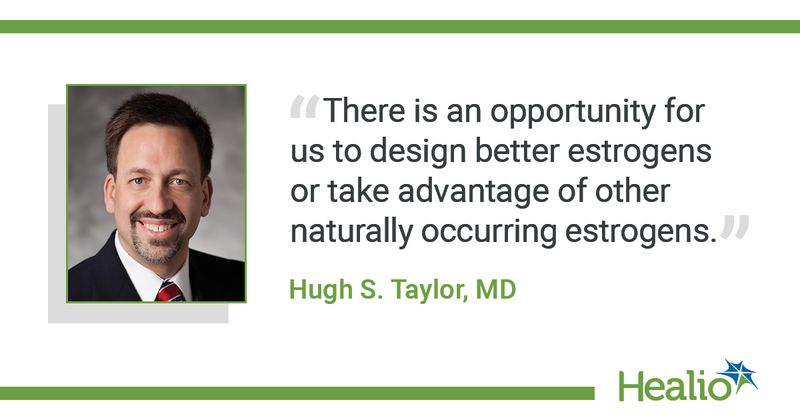Fetal estrogens hold promise for menopausal symptom treatment
Fetal estrogens, considered “weak” steroid hormones detectable only during pregnancy, may improve the risk-benefit profile for the treatment of menopausal symptoms compared with current therapies, according to a speaker.
Selective estrogen receptor modulators (SERMS) are useful estrogens to treat vasomotor symptoms in menopausal women; however, no SERM to date is an effective menopausal monotherapy, Hugh S. Taylor, MD, the Anita O’Keefe Young Professor and chair of obstetrics, gynecology and reproductive sciences at Yale School of Medicine, said during an online presentation at the virtual North American Menopause Society annual meeting.

Additionally, the Women’s Health Initiative has shown that combination hormone therapy was associated with breast cancer, leading researchers to develop therapies that eliminate progestin, Taylor said.
“One major breakthrough has been combining an estrogen with a SERM that may have specific anti-estrogen effects in the tissues where stimulation is not desired — predominantly in the endometrium and breast — but still does not block the effects of estrogen on the central nervous system or bone, allowing for treatment of vasomotor symptoms without a progestin,” Taylor said.
He said the quest for an “ideal” estrogen continues: one that would treat all menopausal symptoms, such as hot flashes and vulvovaginal atrophy, provide bone protection and favorable metabolic effects, and not stimulate breast growth, while also being cardioprotective.
“Unfortunately, there is no such thing as the ‘perfect’ estrogen that has all of the favorable properties we want and none of the negatives,” Taylor said. “It probably does not exist, but there is an opportunity for us to design better estrogens or take advantage of other naturally occurring estrogens that may come closer to that goal of the ideal estrogen.”
Promise of fetal estrogens
Naturally occurring estrogens with more SERM-like properties, such as the fetal estrogens estriol and estetrol, are promising new therapies for the treatment of menopausal symptoms such as hot flashes, Taylor said.
“While both are considered weak estrogens by traditional standards, both have some unique properties that make them very interesting for therapeutic use,” Taylor said. “In particular estetrol, or E4, has a much longer half-life than the very short half-life of estriol, which is very appealing for use as a pharmacologic agent.”
In a randomized, double-blind, placebo-controlled study published in the August issue of Menopause, Ulysses Gaspard, MD, of the department of obstetrics and gynecology at the University of Liege, Belgium, and colleagues analyzed data from 257 postmenopausal women (32 underwent bilateral oophorectomy) who reported at least seven moderate to severe hot flashes daily who received 2.5 mg, 5 mg, 10 mg or 15 mg of estetrol or placebo once daily for 12 weeks. Researchers assessed frequency and severity of vasomotor symptoms and safety, measuring endometrial thickness and monitoring bleeding patterns.
Researchers found that the frequency of moderate to severe hot flashes decreased with all estetrol doses, with the difference in the percentage change of weekly hot flash frequency rising to significance at the 15 mg dose compared with placebo at week 4 (66% vs. 49%; P = .032) and week 12 (82% vs. 65%; P = .022). The decrease in severity of hot flashes was more pronounced at the 15 mg dose of estetrol vs. placebo at weeks 4 (0.59 vs. 0.33; P = .049) and week 12 (1.04 vs. 0.66; P = .049). No endometrial hyperplasia was observed.
“By the time you get to 15 mg dose, you see a robust, significant difference from placebo,” Taylor said.
Research also suggests that estetrol does not stimulate breast cancer cell growth unless at very high doses, Taylor said.
“At very low doses, estradiol stimulates the [breast cancer cell] growth; it takes much higher doses of estetrol or estriol,” Taylor said. “At the lower doses, you actually get some inhibition of [breast cancer] cell growth.”
A ‘complex pathway’
Each estrogen induces a unique, confirmational change in the estrogen receptor, allowing it to bind to different coactivators and corepressors and leading to very different and tissue-specific reactions, depending on which estrogen or SERM is used, Taylor said.
Estetrol levels change from essentially nonexistent in the nonpregnant state to levels as high as estradiol during pregnancy, Taylor said — but why?
“A complex pathway evolved to make estetrol and an even more elaborate pathway is used to make estriol — it involves maternal cholesterol, the placenta, fetal adrenals, fetal liver and back to the placenta to make the final product,” Taylor said. “This is not true for all animals; only humans and higher-order primates make estriol. It must be there for a reason. We ask, what could this reason be?”
In studies treating pregnant mice with estriol, researchers observed a difference in the offspring of treated mice. The offspring of mice exposed to estriol were more likely to become pregnant, have more normal litter sizes and were more likely to give birth at term vs. nontreated mice, despite the uterus looking the same in the offspring of treated vs. untreated animals, Taylor said.
“Not only could estriol exposure permanently change gene expression, it can also change the response to an estrogen stimulus with estradiol later in life,” Taylor said.
Fetal estrogens can bind epigenetic modifiers and change the methylation of genes, allowing long-lasting effects, Taylor said.
“These fetal estrogens are probably there for developmental programming,” Taylor said. “They have a very different role, function and molecular mechanism than estradiol. It is no wonder they may have some unique and very favorable properties for clinical use.”


